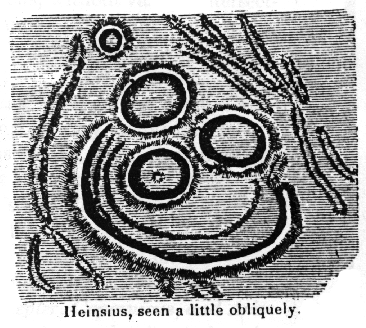.gif)
Heinsius (crater)
Encyclopedia
Heinsius is an eroded lunar
crater
that lies in the southwestern part of the Moon
. It is located to the northwest of the prominent crater Tycho
, and rays
from that formation pass to the north and south of Heinsius as well as marking the rim and interior with material. To the south-southwest of Heinsius is the larger walled plain Wilhelm
.
The southern part of this crater has been heavily damaged by subsequent impacts. Both Heinsius B and Heinsius C lie across the southern and southwestern rim, while Heinsius A is located in the southern interior floor. Together these three satellite craters form a triangular arrangement with the rims only separated by a few kilometers from each other. If Heinsius possessed a central peak, it is now covered by the outer rampart of Heinsius A.
The northern half of the rim is in better shape, although still worn and rounded due to impact erosion. There is a wide shelf along the northeastern inner wall. A small craterlet lies exactly on the northwestern rim. The northern interior floor is relatively level and featureless.
 By convention these features are identified on lunar maps by placing the letter on the side of the crater mid-point that is closest to Heinsius.
By convention these features are identified on lunar maps by placing the letter on the side of the crater mid-point that is closest to Heinsius.
Moon
The Moon is Earth's only known natural satellite,There are a number of near-Earth asteroids including 3753 Cruithne that are co-orbital with Earth: their orbits bring them close to Earth for periods of time but then alter in the long term . These are quasi-satellites and not true moons. For more...
crater
Impact crater
In the broadest sense, the term impact crater can be applied to any depression, natural or manmade, resulting from the high velocity impact of a projectile with a larger body...
that lies in the southwestern part of the Moon
Moon
The Moon is Earth's only known natural satellite,There are a number of near-Earth asteroids including 3753 Cruithne that are co-orbital with Earth: their orbits bring them close to Earth for periods of time but then alter in the long term . These are quasi-satellites and not true moons. For more...
. It is located to the northwest of the prominent crater Tycho
Tycho (crater)
Tycho is a prominent lunar impact crater located in the southern lunar highlands, named after the Danish astronomer Tycho Brahe . To the south is the crater Street; to the east is Pictet, and to the north-northeast is Sasserides. The surface around Tycho is replete with craters of various sizes,...
, and rays
Ray system
A ray system comprises radial streaks of fine ejecta thrown out during the formation of an impact crater, looking a bit like many thin spokes coming from the hub of a wheel. The rays can extend for lengths up to several times the diameter of their originating crater, and are often accompanied by...
from that formation pass to the north and south of Heinsius as well as marking the rim and interior with material. To the south-southwest of Heinsius is the larger walled plain Wilhelm
Wilhelm (crater)
Wilhelm is a lunar crater in the southern part of the Moon, to the west of the prominent Tycho. Portions of the ray material from Tycho lie across the rim and floor of Wilhelm. Attached to its southern rim is the crater Montanari, while Lagalla is attached to the southwest. To the north-northeast...
.
The southern part of this crater has been heavily damaged by subsequent impacts. Both Heinsius B and Heinsius C lie across the southern and southwestern rim, while Heinsius A is located in the southern interior floor. Together these three satellite craters form a triangular arrangement with the rims only separated by a few kilometers from each other. If Heinsius possessed a central peak, it is now covered by the outer rampart of Heinsius A.
The northern half of the rim is in better shape, although still worn and rounded due to impact erosion. There is a wide shelf along the northeastern inner wall. A small craterlet lies exactly on the northwestern rim. The northern interior floor is relatively level and featureless.
Satellite craters

| Heinsius | Latitude | Longitude | Diameter |
|---|---|---|---|
| A | 39.7° S | 17.6° W | 20 km |
| B | 40.0° S | 18.6° W | 23 km |
| C | 40.6° S | 17.9° W | 23 km |
| D | 38.8° S | 20.7° W | 7 km |
| E | 37.8° S | 19.5° W | 17 km |
| F | 40.5° S | 19.7° W | 7 km |
| G | 38.3° S | 14.5° W | 11 km |
| H | 37.4° S | 18.5° W | 8 km |
| J | 39.3° S | 20.4° W | 8 km |
| K | 38.5° S | 18.5° W | 5 km |
| L | 41.2° S | 18.4° W | 8 km |
| M | 40.9° S | 15.3° W | 14 km |
| N | 37.3° S | 14.7° W | 7 km |
| O | 38.8° S | 14.8° W | 5 km |
| P | 39.4° S | 13.8° W | 40 km |
| Q | 39.9° S | 14.5° W | 35 km |
| R | 40.2° S | 20.7° W | 5 km |
| S | 39.6° S | 16.9° W | 7 km |
| T | 39.7° S | 16.5° W | 7 km |

